How to Free Up Space on C Drive in Windows 11/10 [8 Efficient Ways]
C drive is always full? Are you looking for a detailed guide on how to free up space on C drive? Don't worry! We have got you! This article will show you
Why Does C Drive Get So Full?
The C drive is the primary hard drive partition that contains the operating system and related system files. You can check total disk space in Windows 11. It usually becomes full after using the device for some time. This is because it stores the following things:
- Windows operating system, system-related files, and settings
- Installed applications, Windows built-in programs, and downloaded software
- User data, such as documents, photos, and personal data stored on the desktop
Sometimes, you can move unallocated space to the C drive to get more space. There is a link for you to help.
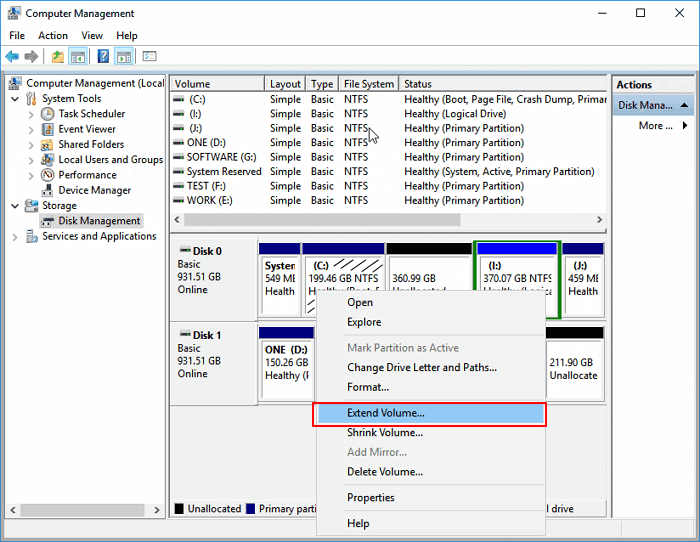
How to Move Unallocated Space to C Drive in Windows 10/11 [Step-by-Step Guide]
Unallocated space can be used to extend another partition or create a new volume. In most cases, users may want to use the unallocated space to extend another partition.
As we can see, the operating system is located on the C drive. Over time, the operating system takes up more and more space as it needs to be constantly updated to improve performance.
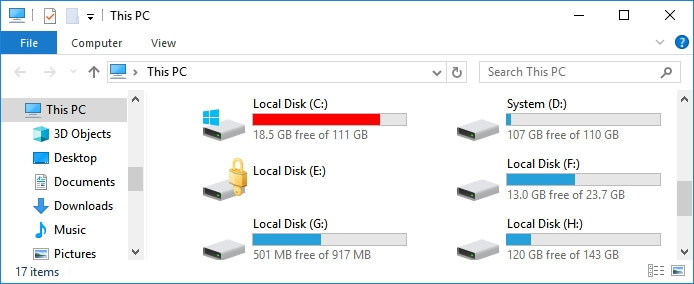
On the other hand, we may save large work files and download large game videos or other files to the c drive for daily use. When too many large or cluttered files are stored on your computer, you may experience some serious performance problems.
By the way, we list some other problems you may run into and you can click these links to help:
However, how to free up space on C drive in Windows? Let's continue reading to learn the methods to solve this problem!
How to Free Up Space on C Drive in Windows - Eight Efficient Ways
There are basically two main directions to free up space on C drive. One is to extend the C drive, and the other is to free up space on the C drive. In this part, we provide eight ways for you to help with free up space on C drive.
Method 1. Extend C Drive to Get More Space
Method 2. Transfer Larger Files to Another Drive
Method 5. Delete Temporary Files
Method 7. Uninstall Apps You No Longer Need
Method 8. Disable Hibernation Mode
So let's learn the specific ways one by
Method 1. Extend C Drive to Get More Space
Extending the C drive is the most effective way to get more space on the C drive. Here, I would like to introduce a professional disk management tool for Windows to you, Qiling Disk Master Professional.
It breaks the rules in Windows and gives more flexibility to extend/move partitions. Most importantly, Qiling Disk Master Professional simplifies the whole process without causing data loss by adding adjacent or non-adjacent unallocated space to the C drive.
Step 1. Right-click on the D: partition with enough free space and select "Resize/Move".
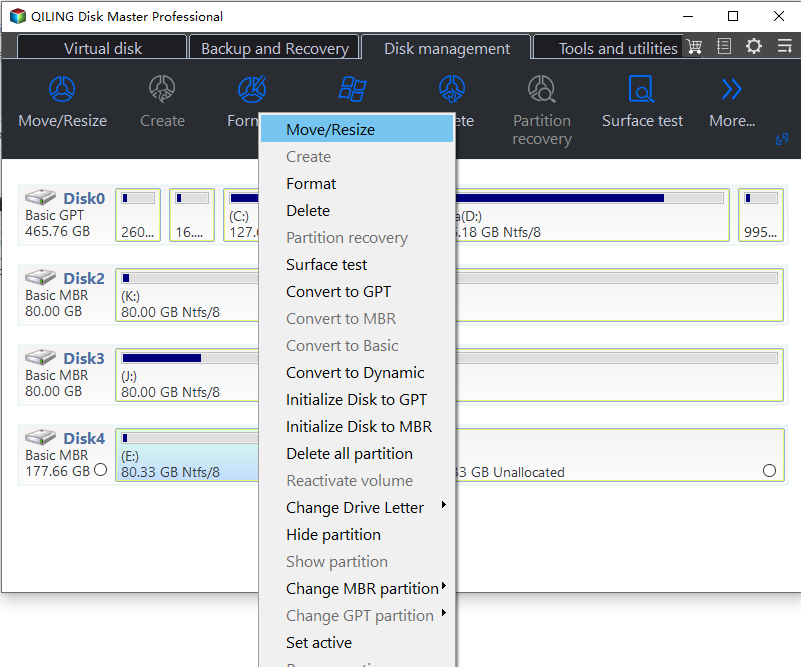
Step 2. Select the target partition - C: drive and drag the partition panel rightward to add the free space from D: drive to C: drive.
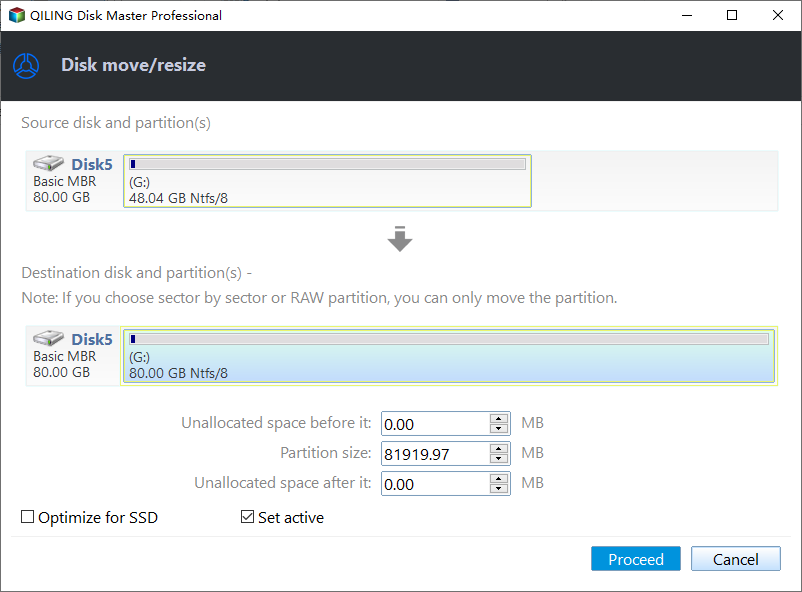
Step 3. Click the "Proceed" to start the process of moving free space from D: drive to C: drive.
Qiling Disk Master is compatible with all Windows systems, and you can even free up disk space on Windows 8 with it. Besides adding the unallocated space to the C drive, Qiling Disk Master still gets many other features, such as:
- Convert MBR to GPT
- Merge and resize Partitions
- Expand SSD C drive across disks
- Check file system errors and bad sectors
- Format hard drive and external hard drives
Therefore, if you are facing disk management problems, you can download it, and it is sure to help you a lot.
Method 2. Transfer Larger Files to Another Drive
You can also transfer larger files to another drive to free up space on the C drive. There is a nice professional PC transfer software, Qiling Disk Master. It can help you transfer large files and programs to another drive efficiently. Let's see how.
Method 3. Run Disk Cleanup
Windows comes with some great tools to help you keep your computer storage neat and tidy. Disk Cleanup is one of these tools. It allows you to delete data, such as temporary files, which can reach gigabytes (GB) of data over time. Follow the steps and have a try.
Step 1. Click "This PC." Then right-click the C drive and choose "Disk Cleanup" from the best match.
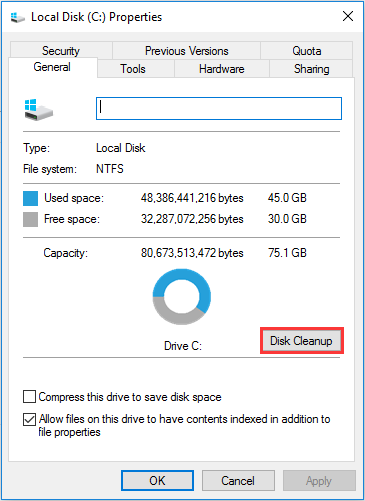
Step 2. It will show you a lot of files and file sizes taken by each file type. Then choose what you don't want. Then, click "OK."
Method 4. Enable Compact OS
Compact OS reduces the footprint of Windows applications to free up disk space, which makes sense in the context of Windows disk cleanup. But before using it, be careful to back up the important data on your C drive.
Step 1. Search for Command Prompt and choose "Run as Administrator."
Step 2. Then, type the command "Compact.exe /CompactOS:always" and hit Enter.
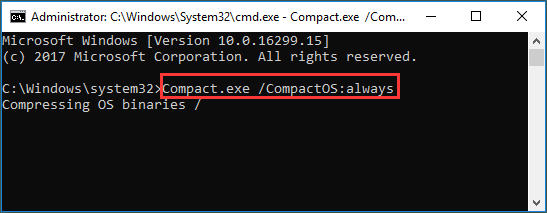
Step 3. It will take 20 minutes or so, and wait patiently.
- Tip
- At any time you want to recover, you can run the opposite command: Compact.exe /CompactOS:never
Method 5. Delete Temporary Files
Temporary files will also occupy the C drive space, so we need to delete them regularly. Now, let's see how.
Step 1. Press "Windows + I" to open Settings, and choose "System" and " Storage."
Step 2. Then, select "This PC (C:)" to analyze.
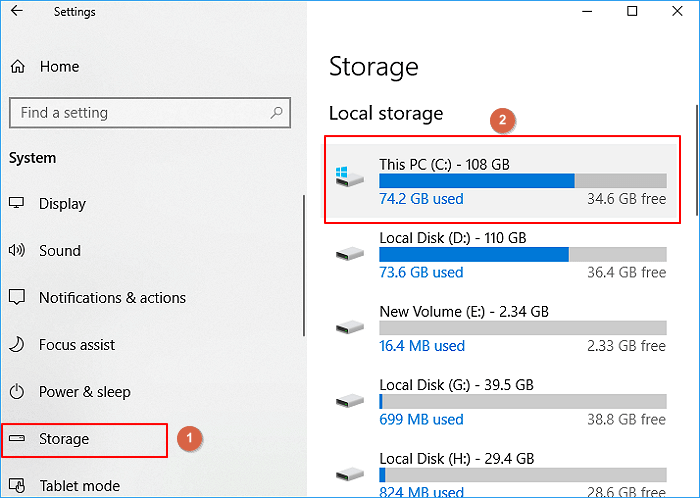
Step 3. Click on "Temporary files." Windows will list "Temporary files," "Recycle bin," "Downloads folder," and more folders in this section.

Step 4. Tick what you want to delete and then click "Remove files."
Method 6. Empty Recycle Bin
When files are deleted, Windows does not remove them from the drive. Instead, they are relocated to the Recycle Bin and marked as deleted. However, since the Recycle Bin gets larger over time, you can first empty it to free up space on the C drive.
Step 1. Open the "Recycle Bin" from the desktop.
Step 2. Select all the files and documents in the Recycle Bin, right-click on them, and select "Delete."

Method 7. Uninstall Apps You No Longer Need
If you have installed some programs that were used to solve your problem but now you no longer need them, you can uninstall them to free up space on your C drive.
Step 1. Right-click on the Windows Start menu and click on Programs and Features.
Step 2. Then right-click on the program you no longer need and select "Uninstall."
Step 3. Repeat this process to remove the rest of the unnecessary applications.
Method 8. Disable Hibernation Mode
Hibernation in computing is the process of powering off the computer while maintaining its state. If you have enabled Hibernate mode in Windows, it will also take up several gigabytes of space on your C drive, so follow the steps below to disable it.
Just open CMD and run the following command: Powercfg /hibernate off

Then, you can disable hibernation mode.
Try these ways to free up space on your C drive. By the way, there are some links for you if you have problems, such as:
Conclusion
Well, do you know how to free up space on C drive now? It is a common question among Windows users. We provide eight efficient ways for you to free up space on C drive. You can choose one easy way based on your needs. By the way, if you have other questions about freeing up space on C drive, continue reading the next paragraph.
FAQs About How to Free Up Space on C Drive
This part lists three questions related to how to free up space on C drive. Continue to read if you need.
1. What can I delete from C drive to free up space?
You can remove recycle bin files, upgrade log files, Windows Update Cleanup files, temporary internet files, device driver packages, and other temporary files.
2. Why do I have so little space on my C drive?
The reasons for low C drive space may be as follows.
- Viruses and malware may keep generating files to fill up your C drive.
- You may have saved large files to a C: drive, but you don't know.
- Pages files, previous Windows installations, temporary files, and other system files may have taken up space on the C drive.
3. How can I solve the C drive full problem?
You can try the following methods:
- Uninstall a program
- Remove duplicate files
- Remove large, unnecessary files
- Run Disk Cleanup
- Delete temporary files
- Extend C drive via Qiling Disk Master
Related Articles
- How to Check Total Hard Disk Size in Windows 10/8/7 in Every Possible Way
- We Couldn't Create a New Partition or Locate an Existing One
- Fixed: Unmountable Boot Volume Windows 11
- Your Best Guide to Clone Windows to M.2 SSD [2024 Tutorial]
Do you want to know the process to clone Windows to M.2? You can find the right ways and complete the steps with the following tutorial.